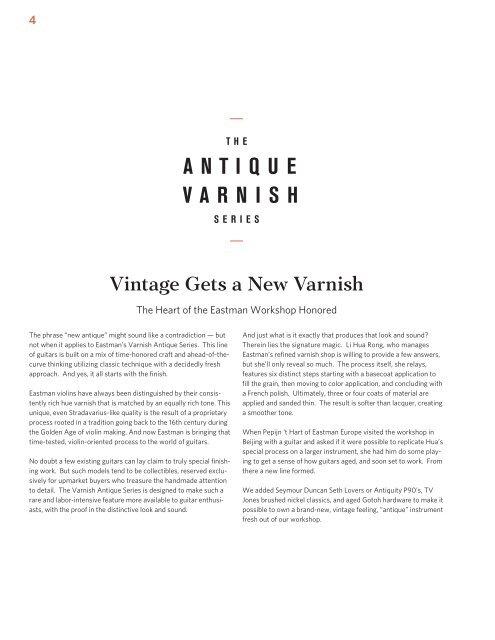2017 catalog
Create successful ePaper yourself
Turn your PDF publications into a flip-book with our unique Google optimized e-Paper software.
4<br />
THE<br />
ANTIQUE<br />
VARNISH<br />
SERIES<br />
Vintage Gets a New Varnish<br />
The Heart of the Eastman Workshop Honored<br />
The phrase “new antique” might sound like a contradiction — but<br />
not when it applies to Eastman’s Varnish Antique Series. This line<br />
of guitars is built on a mix of time-honored craft and ahead-of-thecurve<br />
thinking utilizing classic technique with a decidedly fresh<br />
approach. And yes, it all starts with the finish.<br />
Eastman violins have always been distinguished by their consistently<br />
rich hue varnish that is matched by an equally rich tone. This<br />
unique, even Stradavarius-like quality is the result of a proprietary<br />
process rooted in a tradition going back to the 16th century during<br />
the Golden Age of violin making. And now Eastman is bringing that<br />
time-tested, violin-oriented process to the world of guitars.<br />
No doubt a few existing guitars can lay claim to truly special finishing<br />
work. But such models tend to be collectibles, reserved exclusively<br />
for upmarket buyers who treasure the handmade attention<br />
to detail. The Varnish Antique Series is designed to make such a<br />
rare and labor-intensive feature more available to guitar enthusiasts,<br />
with the proof in the distinctive look and sound.<br />
And just what is it exactly that produces that look and sound?<br />
Therein lies the signature magic. Li Hua Rong, who manages<br />
Eastman’s refined varnish shop is willing to provide a few answers,<br />
but she’ll only reveal so much. The process itself, she relays,<br />
features six distinct steps starting with a basecoat application to<br />
fill the grain, then moving to color application, and concluding with<br />
a French polish. Ultimately, three or four coats of material are<br />
applied and sanded thin. The result is softer than lacquer, creating<br />
a smoother tone.<br />
When Pepijn ‘t Hart of Eastman Europe visited the workshop in<br />
Beijing with a guitar and asked if it were possible to replicate Hua’s<br />
special process on a larger instrument, she had him do some playing<br />
to get a sense of how guitars aged, and soon set to work. From<br />
there a new line formed.<br />
We added Seymour Duncan Seth Lovers or Antiquity P90’s, TV<br />
Jones brushed nickel classics, and aged Gotoh hardware to make it<br />
possible to own a brand-new, vintage feeling, “antique” instrument<br />
fresh out of our workshop.


